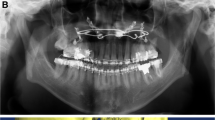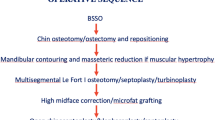Abstract
Background
Surgery-first sagittal split ramus osteotomies (SF-SSRO) are an effective treatment for patients with dental malocclusion. However, some patients with mandibular prognathism usually have facial deficiencies which cannot be corrected completely after orthognathic surgery. These are not accepted because the remaining facial contours are in disharmony.
Methods
Twenty-five patients, who were unsatisfied with their appearances after SF-SSRO and orthodontics, were included. The preoperative CTs were used to investigate patients for facial deformity. To achieve a harmonious facial contour, mandible long-curve osteotomy/mandible U-shaped osteotomy, genioplasty or facial autologous fat grafting was selected depending on patients’ contour deformities with the assistance of CAD.
Results
Among the patients who underwent osteotomy, the gonial angle was improved from 111.16° ± 9 to 111.58° ± 9.06 after SF-SSRO because of distal fragment setback and rotation. After facial refine surgery, the gonial angle was significantly increased to 121.69°±2.41 (p < 0.05). And the mandibular width was decreased from 11.29 cm ± 0.44 to 10.45 cm ± 0.39 (p < 0.05) after mandibular outer plate griding. All patients were shown no signs of infection, massive bleeding, and osteonecrosis in the early stage. After follow-up time, they were all satisfied with their results and most of them recovered from lip numbness.
Conclusions
This study indicated the clinical feasibility of two-stage orthognathic and facial bone contouring surgery for the treatment of dentofacial deformities. Two-stage facial contouring surgery can provide esthetic improvement for more accuracy in refining the facial contour.
Level of Evidence IV
This journal requires that authors assign a level of evidence to each article. For a full description of these Evidence-Based Medicine ratings, please refer to the Table of Contents or the online Instructions to Authors www.springer.com/00266.





Similar content being viewed by others
References
De Nuccio F, De Nuccio F, D’Emidio MM, Pelo S (2017) Surgery-first: a new approach to orthognathic surgery. Oral Implantol (Rome) 9:98–102
Hunsuck EE (1968) A modified intraoral sagittal splitting technic for correction of prognathism. J Oral Surg 26:250–253
Yunfeng L, Zhiai H, Bin Y, Yao L, Xiaochun R, Songsong Z (2016) Combined use of facial osteoplasty and orthognathic surgery for treatment of dentofacial deformities. J Oral Maxillofac Surg 74:2505.e1-2505.e12
Chul-Hwan K, Ju-Hyun L, Ju-Yeon C, Jae-Hoon L, Kyung-Wook K (2007) Skeletal stability after simultaneous mandibular angle resection and sagittal split ramus osteotomy for correction of mandible prognathism. J Oral Maxillofac Surg 65:192–197
Yanju X, Xiumei S, Lin W, Yaoyao Z, Kai C, Guomin W (2017) The application of 3d printing technology for simultaneous orthognathic surgery and mandibular contour osteoplasty in the treatment of craniofacial deformities. Aesthetic Plast Surg 2017:1413–1424
Jae-Seung K, Hyun-Ho C, Sung-Ho R, Jae-Hyun K, Seung-Ho L (2001) Gonial angle reduction during mandibular sagittal split ramus osteotomy. J Kor Oral Maxillofac Surg 27:258–265
Al-Hiyali A, Ayoub A, Ju X, Almuzian M, Al-Anezi T (2015) The impact of orthognathic surgery on facial expressions. J Oral Maxillofac Surg 73:2380–2390
Jeffrey L, Leonard K, Michael Y (2018) Refining post-orthognathic surgery facial contour with computer-designed/computer-manufactured alloplastic implants. Plast Reconstr Surg 142:747–755
Chenzhi L, Xiaolei J, Xianlei Z, Guodong S (2019) En-bloc U-shaped osteotomy of the mandible and chin for the correction of a prominent mandibular angle with long chin. J Craniofac Surg 30:1359–1363
Chao Z, Li T, Fuanchiang C, Jiajie X, Jianjian L, Fang X, Jingyi Z, Meibang X, Xiaolei J (2014) Single stage surgery for contouring the prominent mandibular angle with a broad chin deformity: en-bloc Mandibular Angle-Body-Chin Curved Ostectomy (MABCCO) and Outer Cortex Grinding (OCG). J Craniomaxillofac Surg 42:1225–1233
Yu-Fang L, Yun-Fang C, Chuan-Fong Y, Yin-An C, Yu-Ray C (2019) Long-term outcomes of bimaxillary surgery for treatment of asymmetric skeletal class III deformity using surgery-first approach. Clin Oral Investig 23:1685–1693
Jiyin L, Sun-Youl R, Hong-Ju P, Min-Suk K, Seunggon J, Jeong JH, Hee-Kyun O (2017) Changes in condylar position after BSSRO with and without Le Fort I osteotomy via surgery-first approach in mandibular prognathism with facial asymmetry. Oral Surg Oral Med Oral Pathol Oral Radiol 123:661–669
Farhad G, Hamed G, Saeid T, Hamid Reza E (2018) Improvement of esthetic, functional, and social well-being after orthognathic surgical intervention: a sampling of postsurgical patients over a 10-year period from 2007 to 2017. J Oral Maxillofac Surg 76:2398–2403
Reitzik M (1980) Skeletal and dental changes after surgical correction of mandibular prognathism. J Oral Surg 38:109–116
Xiaobin M, Tao W, Dongkun Y, Guimei Z (2011) The dynamics of blood supply of animal experimental study for simultaneous mandibular sagittal split osteotomy and mandibular angle plasty. J Chongqing Med Univ 6:718–720
Epker BN (1984) Vascular considerations in orthognathic surgery. I. Mandibular osteotomies. Oral Surg Oral Med Oral Pathol 57:467–472
Baek SM, Baek RM, Shin MS (1994) Refinement in aesthetic contouring of the prominent mandibular angle. Aesthetic Plast Surg 18:283–289
Liebregts J, Xi T, Timmermans M, de Koning M, Bergé S, Hoppenreijs T, Maal T (2015) Accuracy of three-dimensional soft tissue simulation in bimaxillary osteotomies. J Craniomaxillofac Surg 43:329–335
Rafael D, Cesar RA, Celso B, Cassio RA (2018) Autologous free fat grafting for management of the facial contour asymmetry. J Craniofac Surg 29:878–886
Denadai R, Buzzo CL, Raposo-Amaral CA, Raposo-Amaral CE (2019) Facial contour symmetry outcomes after site-specific facial fat compartment augmentation with fat grafting in facial deformities. Plast Reconstr Surg 143:544–556
Yuching W, Christopher W, Betty P, Huiling C, Yuehtse L, Yenchang H, Chunshin C, Yufang L, Philip C, Yuray C (2017) Orthognathic surgery with simultaneous autologous fat transfer for correction of facial asymmetry. Plast Reconstr Surg 139:693–700
Youwei C, Lunjou L (2011) Facial asymmetry: etiology, evaluation, and management. Chang Gung Med J 34:341–351
Takanobu M, Kotaro Y (2015) How does fat survive and remodel after grafting? Clin Plast Surg 42:181–190
Roger K Jr, Raoul-Emil K, Jorge LH, Khalil K, Luca L, Dennis O (2014) Diffusion and perfusion: the keys to fat grafting. Plast Reconstr Surg Glob Open 2:e220
Author information
Authors and Affiliations
Corresponding author
Ethics declarations
Conflict of interest
The authors declare that they have no conflict of interest.
Human and Animal Participants
All procedures performed in studies involving human participants were in accordance with the ethical standards of the hospital research committee and with the 1964 Helsinki Declaration and its later amendments or comparable ethical standards.
Informed Concent
Patient consent was obtained from all participants. The poll of patients in this study and patient's data have not used in other published papers.
Additional information
Publisher's Note
Springer Nature remains neutral with regard to jurisdictional claims in published maps and institutional affiliations.
Rights and permissions
About this article
Cite this article
Lai, C., Song, G., Zong, X. et al. Facial Contour Refining after Surgery-First SSRO with Computer-Assisted Design in East Asians. Aesth Plast Surg 45, 1564–1572 (2021). https://doi.org/10.1007/s00266-021-02181-y
Received:
Accepted:
Published:
Issue Date:
DOI: https://doi.org/10.1007/s00266-021-02181-y




